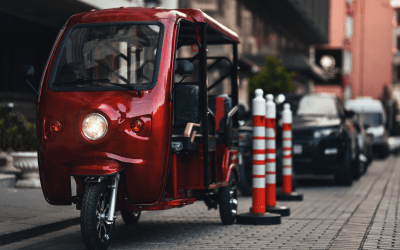What is battery swapping?
Battery swapping is a technology that allows battery-powered vehicles to switch a depleted battery with a fully charged one in a matter of minutes. The benefits of using swap stations instead of traditional charging points is that they offer faster charging times, eliminate wait time and enable consumers to avoid peak hours. The concept has taken off in Asia, particularly within China and Taiwan, as automakers and two-and-three wheeler (2/3 wheeler) companies seek to speed the pace at which consumers can replenish their battery charge.
Battery swap stations can take different forms depending on the operator. The most common in the passenger electric vehicle (EV) segment is Nio’s swap stations operating across China and Europe and Gogoro’s 2/3 wheeler stations in Taiwan. In Nio’s stations, car owners can drive their vehicles into the station, where there are 13 available batteries to reserve in advance. The battery from the underside of the car will then be remotely switched out and replaced with a fully charged alternative, all taking place in under 5 minutes. With Gogoro, by comparison, the station is manually operated by consumers due to the smaller size of the batteries. In this case, a charged battery can be lifted out of a station, where 30 charged batteries are available.

What demand do we expect from battery swapping?
Fastmarkets expects that battery swapping will require over 117 gigawatt hours (GwH) of batteries by 2033, with a notable upside risk for this number to increase due to the pace of uptake. In terms of markets, we expect that China will hold 69% of the market, with operators such as Nio, CATL, Aulton, GAC and a JV between Geely and Livan leading the development of swap stations in the market. Notably, CATL is investing in swap stations for passenger EVs, as well as heavy electric vehicles, with its QIJI Heavy-duty truck swap services, the first of its kind globally. Gogoro, with a forecasted 12,000 2/3 wheeler swap stations to be operational by year-end 2023, will lead the market in Taiwan. This is in addition to KYMCO, which can hold, in some cases, 50 batteries in one 2/3 wheeler swap station.

Will battery swapping replace charging infrastructure?
We expect that traditional battery charging points will remain the dominant choice for the EV market going forward, but that battery swapping will continue to rise in popularity over time. We expect this to happen predominantly in Asia. This is likely to happen in the electric 2/3 wheeler market, which is expanding rapidly. Our forecast below shows that we expect sales to reach over 48 million units by 2033.
China will make up 46% of that market and India 39%, representing over 22 million and 19 million units. This large fleet presents issues for traditional charging. It would require a large area of land to install sufficient charging points for such a high number of 2/3 wheelers, with the longer wait times also presenting scenarios where potentially hundreds of people could be waiting for their vehicle to recharge.
We expect slower uptake in Europe and North America for two reasons. Firstly, EV adoption remains more nascent in these markets compared to China, particularly in the 2/3 wheeler market, making traditional charging points more attractive at this point. Secondly, the automakers that do offer swaps as a charging option are predominantly based in Asia. Until we see greater demand for these brands across Europe and North America, we won’t see a notable rise in swapping. That said, particularly in urban areas, swaps offer utility to densely populated cities looking to improve the efficiency of their charging infrastructure. We expect to see uptake of the stations in dense cities in Europe in the foreseeable future. As Nio builds their fleet of battery swap stations in Europe, we also expect that other companies will follow suit as confidence in the infrastructure builds.
Keep up to date with the latest news and insights on our dedicated battery materials market page.






